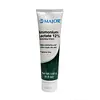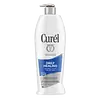What's inside
What's inside
 Key Ingredients
Key Ingredients

 Benefits
Benefits

 Concerns
Concerns

 Ingredients Side-by-side
Ingredients Side-by-side

Water
Skin ConditioningLactic Acid
BufferingParaffinum Liquidum
EmollientGlyceryl Stearate
EmollientPEG-100 Stearate
Cetyl Alcohol
EmollientGlycerin
HumectantAmmonium Hydroxide
BufferingPropylene Glycol
HumectantLaureth-4
EmulsifyingMagnesium Aluminum Silicate
AbsorbentPEG-40 Stearate
EmulsifyingMethylparaben
PreservativePropylparaben
PreservativeMethylcellulose
Emulsion StabilisingWater
Skin ConditioningGlycerin
HumectantDistearyldimonium Chloride
Petrolatum
EmollientIsopropyl Palmitate
EmollientCetyl Alcohol
EmollientDimethicone
EmollientMethylparaben
PreservativeEthylparaben
PreservativeParfum
MaskingSodium Chloride
MaskingCetyl-Pg Hydroxyethyl Palmitamide
Skin ConditioningButylene Glycol
HumectantButyrospermum Parkii Butter
Skin ConditioningEucalyptus Globulus Leaf Extract
PerfumingSodium Lauroyl Lactylate
EmulsifyingAcacia Senegal Gum
MaskingGelatin
Ceramide NP
Skin ConditioningCeramide AP
Skin ConditioningAcetylphytosphingosine
Skin ConditioningCarbomer
Emulsion StabilisingXanthan Gum
EmulsifyingCeramide EOP
Skin ConditioningWater, Glycerin, Distearyldimonium Chloride, Petrolatum, Isopropyl Palmitate, Cetyl Alcohol, Dimethicone, Methylparaben, Ethylparaben, Parfum, Sodium Chloride, Cetyl-Pg Hydroxyethyl Palmitamide, Butylene Glycol, Butyrospermum Parkii Butter, Eucalyptus Globulus Leaf Extract, Sodium Lauroyl Lactylate, Acacia Senegal Gum, Gelatin, Ceramide NP, Ceramide AP, Acetylphytosphingosine, Carbomer, Xanthan Gum, Ceramide EOP
Alternatives
Ingredients Explained
These ingredients are found in both products.
Ingredients higher up in an ingredient list are typically present in a larger amount.
Cetyl Alcohol is a fatty alcohol. Fatty Alcohols are most often used as an emollient or to thicken a product.
Its main roles are:
Though it has "alcohol" in the name, it is not related to denatured alcohol or ethyl alcohol.
The FDA allows products labeled "alcohol-free" to have fatty alcohols.
Learn more about Cetyl AlcoholGlycerin is already naturally found in your skin. It helps moisturize and protect your skin.
A study from 2016 found glycerin to be more effective as a humectant than AHAs and hyaluronic acid.
As a humectant, it helps the skin stay hydrated by pulling moisture to your skin. The low molecular weight of glycerin allows it to pull moisture into the deeper layers of your skin.
Hydrated skin improves your skin barrier; Your skin barrier helps protect against irritants and bacteria.
Glycerin has also been found to have antimicrobial and antiviral properties. Due to these properties, glycerin is often used in wound and burn treatments.
In cosmetics, glycerin is usually derived from plants such as soybean or palm. However, it can also be sourced from animals, such as tallow or animal fat.
This ingredient is organic, colorless, odorless, and non-toxic.
Glycerin is the name for this ingredient in American English. British English uses Glycerol/Glycerine.
Learn more about GlycerinMethylparaben is a preservative and is a paraben. It is used to prevent the growth of fungus, mold, and other harmful bacteria. Parabens are chemicals used as preservatives in both cosmetics and food.
Methylparaben can be synthetically created. It can also be found naturally in some fruits, such as blueberries.
Oftentimes, Methylparaben is combined with other parabens to help increase the shelf life.
The safety of Methylparaben is currently being studied. While ongoing studies are looking into the safety of parabens, the results have been very mixed. Some studies have not found Methylparaben to be harmful.
Learn more about MethylparabenWater. It's the most common cosmetic ingredient of all. You'll usually see it at the top of ingredient lists, meaning that it makes up the largest part of the product.
So why is it so popular? Water most often acts as a solvent - this means that it helps dissolve other ingredients into the formulation.
You'll also recognize water as that liquid we all need to stay alive. If you see this, drink a glass of water. Stay hydrated!
Learn more about Water